Raptor Chess
Raptor Chess was developed from the game Birds and Ninjas, to which it is identical except that the Raptor, the exact diagonal equivalent to the Bird, replaces the Ninja Guard.The nature of the game is completely changed, and play can be fast and furious.
One can compare the gameplay to having 4 bishops and 4 rooks on a board, but even that is not accurate enough. The fly-over capture abilities, plus the short range leaping possessed by both new pieces adds an entirely new dimension to the game.
Setup
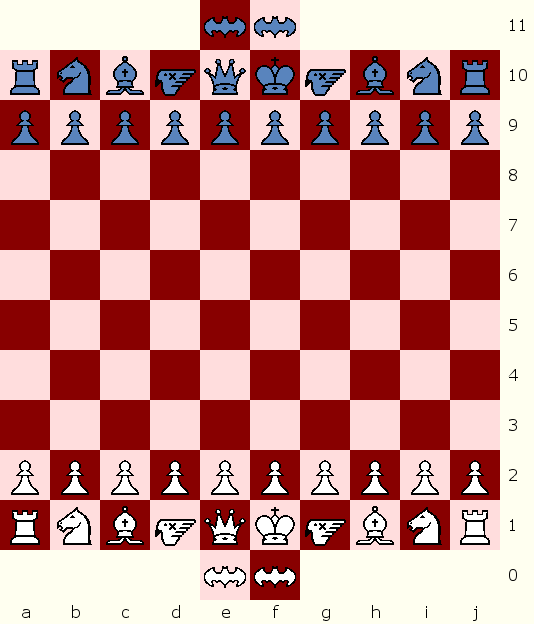 |
Raptor Chess Main Start position
Coordinates for white. (black mirrors white)
Rooks on a1, j1 Knights on b1,i1 Bishops on c1,h1 Raptors on d1, g1 Queen on e1 King on f1 Birds on e0,f0. |
Pieces
The Bird (or Flying Bomber)
The Bird, when not capturing, moves exactly like the Rook. When capturing it flies over its prey orthogonally and lands on the square immediately after it.It can also make a special move by jumping over an adjacent friendly piece. It can also capture by landing on the same square as an enemy piece exactly two square away orthogonally. And, as the diagram shows, it can also capture two pieces by combining both capture mechanisms.
The 2 square range helicopter move/capture is identical to the Dabbabah except for the double capture.It is easier to remember the Bird's movement as a combination of the standard move with the move of the Dabbabah.
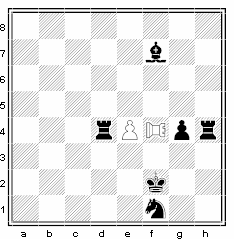 diag 1 (sideways rook rep. the Bird) |
Diag. 1: The Bird on f4 is posing multiple threats to black's pieces.
It is threatening to destroy the black bishop on f7 by leaping f4-f8. It is threatening the black rook on d4 by moving f4-d4. It cannot land on any squares beyond d4. This same short-range prowess gives it the ability to threaten f4-h4, flying over and bombing pawn on g4 and landing/bombing rook on h4. The Bird cannot move to g4 by capturing the pawn, it must eliminate both the pawn and the rook. If there was no rook on h4 then the Bird can just capture the pawn by leaping f4-h4. The Bird IS giving check to the king because it is exactly 2 squares away, and the bird can land on f2. The Bird is not threatening the knight on f1 since it is more than 2 squares away and there is no empty square beyond it. If the king moves, the knight will not be under attack either. |
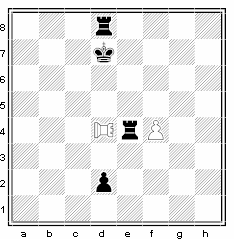 diag 2 (sideways rook rep. flying bomber) |
Diag 2: Here the Bird is hampered by Black’s Pieces.
It is not checking the king at d7 because there is no empty square behind it (and not exactly 2 squares away from it). The rook on d8 is pinned, because moving it would enable the king to be captured. However, the king can simply move away and the rook on d8 is not threatened because there is no empty square beyond it. The rook on e4 is adjacent to the flying bomber and threatening it. But the Bird cannot do anything because the white pawn occupies f4 and the Bird needs an empty square after its target. If f4 was an empty square, the Bird could capture the rook, and if there was another enemy piece on f4 instead of the white pawn, then the bird could have captured both pieces. The Bird does attack the pawn on d2. It can fly d4-d1 OR even d4-d2 to eliminate the pawn. Because it is 2 squares away, the bird can land on the same square as its target. |
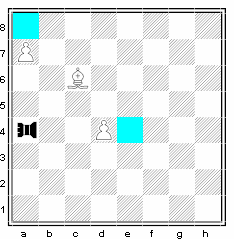 diag 3 (sideways rook rep. flying bomber) |
Diag 3:
Here the black bird is threatening white’s pawns at d4 and a7.
However, the white bishop is defending both pawns (colored squares). To make matters worse the bishop is also attacking the bird! |
The Raptor
The Raptor, when not capturing, moves exactly like the bishop. When capturing it flies over its prey along the diagonal and lands on the square immediately after it. Additionally, like the Bird, it can also make a special move by jumping over a diagonally adjacent friendly piece. Similarly, it can also capture by landing on the same square as an enemy piece exactly two square away diagonally. And, as the diagram shows, it can also capture two pieces by combining both capture mechanisms.
Simply put the Raptor is a diagonal version of the Bird.
It can also be described as a two step diagonal jumper (the Alfil)
combined with the non capturing bishop move, and the diagonal fly over capture mechanism.
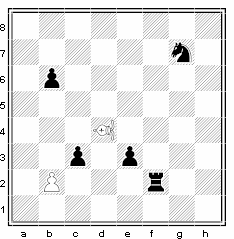 |
The Raptor on d4 can capture pawn on b6 by flying over to
a7 or by flying to b6 (2 square helicopter landing)
It can capture the knight by flying over to h8. It can capture both the pawn and rook by flying over to f2. It cannot fly beyond f2 and it must capture both since it cannot move to e3. The Raptor cannot capture the pawn at c3 since it is blocked by the white pawn at b2. Note that the ninja guard could have captured on c3, as well as on e3, f2, or b6 but it could not have captured the knight at g7. Diag shows smaller board than that used for game. |
Rules
The rules in Raptor Chess are the same as in chess except for using the new pieces and for the following modifications :-
Castling:
The usual castling criteria apply: No piece must be in between
the spaces travelled by the king and castling rook, cannot castle out of check,
King cannot pass over or land on squares attacked by enemy, but rook can.
Castling is flexible with the king able to travel 1,2, 3, or 4 squares towards the rook. There are 7 possible castling positions: The choice of castling positions will depend on whether it is immediately necessary for the king to be nearer the wing or for the rook to be centralized. Note that the rook must always be next to the king after castling.-
1 space transposition - King Side Castling
White moves King one space from f1-g1 and rook from j1-f1
Black moves King one space from f10-g10 and rook from j10-f10 -
1 space transposition - Queen Side Castling
White moves King one space from f1-e1 and rook from a1-f1
Black moves King one space from f10-e10 and rook from a10-f10 -
2 space transposition - King Side Castling
White moves King two spaces from f1-h1 and rook from j1-g1
Black moves King two spaces from f10-h10 and rook from j10-g10 -
2 space transposition - Queen Side Castling
White moves King two spaces from f1-d1 and rook from a1-e1
Black moves King two spaces from f10-d10 and rook from a10-e10 -
3 space transposition - King Side Castling
White moves King three spaces from f1-i1 and rook from j1-h1
Black moves King three spaces from f10-i10 and rook from j10-h10 -
3 space transposition - Queen Side Castling
White moves King three spaces from f1-c1 and rook from a1-d1
Black moves King three spaces from f10-c10 and rook from a10-d10 -
4 space transposition - Queen Side Castling
White moves King four spaces from f1-b1 and rook from a1-c1
Black moves King four spaces from f10-b10 and rook from a10-c10
-
1 space transposition - King Side Castling
-
Pawn moves: A pawn situated on the lower half of the board can at any time move forward 1-3 vacant squares to reach the center of the board (rank 5 for white, rank 6 for black). Once the pawn reaches the center row, it can move forward only one square at a time.
Some examples: The white pawn at f2 can start f2-f5 or it can move f2-f4 then f4-f5, or f2-f3 followed by f3-f5, or move f2-g3 to capture enemy piece at g3 followed by g3-g5 next time it moves. - En Passant: If a Pawn moves two or three squares initially and passes an opposing Pawn on the fourth or fifth rank, the Pawn may be captured en passant. E.g. White pawn on a2 black pawn on b4. If the white pawn moves from a2 to a4 or a5, the black pawn on b4 can capture it as if it had moved to a3. Similarly, if the black pawn is on b5 instead and the white pawn moves to a5 from a2 then the black pawn can capture the white pawn as if it moved to a4. Note in this case the white pawn can still avoid the black pawn by moving to a3 instead.
If a pawn slides forward 2 squares on its second move, it can also be captured en passant by an opposing pawn on the fifth rank. E.g. white pawn on a3 and black pawn on b5. White plays a3-a5, black pawn on b5 can capture the pawn en passant by moving to a4.
Capturing en passant is optional unless it is the only legal move available. The capture must be made on the next move. - Pawn promotion: Pawns can now promote to: Queen, Bishop, Knight, Rook, Raptor or Bird on the 10th rank only.
Notes
- Relative Values: It is sometimes hard to gauge the relative values of the pieces. Here is a rough guideline:
Knight=3 pawns
Bishop=4 pawns
Raptor ~ 3-4 pawns
Bird ~ 4 - 5.5 pawns
Rook=6 pawns
Queen=11 pawns. -
Ability to Checkmate:
The raptor alone cannot mate a lone king with the aid of a king, but two opposite colored raptors can. They must utilize
the two square attack mode quite often.
The flying bomber with the aid of the king can checkmate a lone king, but it is very tricky since the king, when at the edge of the board, can often escape. By utilizing the two square attack it is possible to checkmate. - Knight vs Bishop: Because of the larger board, exchanging a bishop for a knight is definitely losing the exchange, though there are cases where the knight is at least as powerful as the bishop.
- King Protection: It may not always be desirable to castle, sometimes the king can have adequate protection in the rear of the palace.
Raptor Chess is the third game from the Birds and Ninjas family.
- Birds and Ninjas is the first game utilizing this board shape.
-
Birds and Leaping Ninjas is the second game and was released as a subvariant.
You can play it using board position 2 from this preset page. Click here to play.
Coming soon: 3 more games using the same board!
 This 'user submitted' page is a collaboration between the posting user and the Chess Variant Pages. Registered contributors to the Chess Variant Pages have the ability to post their own works, subject to review and editing by the Chess Variant Pages Editorial Staff.
This 'user submitted' page is a collaboration between the posting user and the Chess Variant Pages. Registered contributors to the Chess Variant Pages have the ability to post their own works, subject to review and editing by the Chess Variant Pages Editorial Staff.
By Charles Daniel.
Web page created: 2007-12-17. Web page last updated: 2007-12-17
